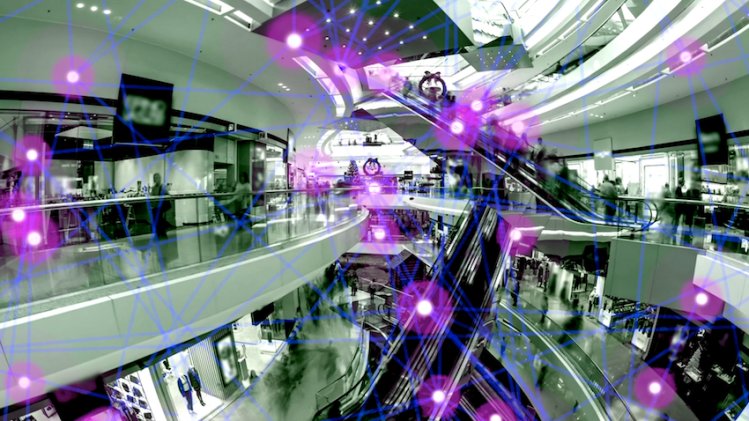Want smarter insights in your inbox? Sign up for our weekly newsletters to get only what matters to enterprise AI, data, and security leaders. Subscribe Now
Apple’s iBeacons are so last news cycle.
Early next year, Paris-based company Ubudu is launching in the U.S. what it says is the first implementation of mesh beacons, called uBeacon Mesh.
Before seeing how this could change the beacon landscape, let’s look at how standard beacons work.
Imagine that standard beacons — small electronic devices, of which Apple’s iBeacon is the best known implementation — are like beacons of light, shining a signal to let you know where they are. Retailers mount them on ceilings or walls in a store. At intervals, the beacon broadcasts very small packets of data via Bluetooth Low Energy that simply say, “Hi, I’m here,” with basic ID information describing exactly where it is in a specific store.
A customer then walks into that store. Because she’s inside a building, the GPS positioning for her smartphone may not work well. That’s where the “Hi, I’m here” comes in. The phone listens to the beacon’s location data, and then an app on the phone can transmit that data via Wi-Fi or a cellular data network to the app’s server.
The server responds to this trigger by sending back location-relevant information — such as sale info, a welcome message, or a coupon — that is tailored for that precise spot. Usually, it’s just the changeable data — pricing or sales info, for instance — that is transmitted, and the byte-heavier graphics or other relatively large files reside in the smartphone’s app.
But, for this to work, the store needs to have an expensive Wi-Fi network, or the customer needs to be able to access her data network. And the standard beacons can only be controlled and monitored locally in that one store, through Bluetooth (if each beacon is paired with a smartphone) or a physical connection. Pairing sets up a connection between Bluetooth devices, such as when you pair your smartphone with your Bluetooth headphones.
Enter mesh beacons
“Mesh beacons enable a world of new consumer experiences which wouldn’t be otherwise possible with conventional beacons,” Ubudu cofounder and chief marketing officer Thomas Saphir told VentureBeat.
Mesh beacons, which utilize capabilities in version 4.1 of Bluetooth that came out last December, turn the current generation of location-broadcasting beacons into a two-way, Net-connected network.
Unlike standard beacons, Ubudu’s uBeacons — which also support the iBeacon standard — can receive a few kilobits per second of data back from customers’ smartphones without pairing, and they can each talk via Bluetooth to other mesh beacons. If one of the mesh beacons is connected to the Internet, the mesh network can communicate with the cloud.
This means, for instance, that a customer standing in an aisle could send a very brief message via her smartphone app to the store, asking for assistance. Customer phones would need to have Bluetooth 4.0, which is supported by a majority of phones.
In a mesh network, as with standard beacons, the graphics of a coupon and other byte-heavy components of a location-targeted message can live in the app. But uBeacons can receive the dynamic info — pricing, product data, and the like — via the Net through the mesh network, and then send that data to the customer. Wi-Fi or cellular data is not required for the customer, as is the case with standard beacons.
“You’re not going to be transmitting videos,” Saphir said about the relatively slow Bluetooth Low Energy transmission used in mesh, adding that the timely text could be transmitted fast enough to be immediately relevant to a customer.
Additionally, all mesh networks in all locations can be controlled via one browser-based dashboard. A Ubudu SDK is available for iOS and Android, so retailers can create their own app or can use one from a third-party, such as Shopkick. In addition to the beacons themselves, Ubudu also provides server software.
Talking to the cloud
Like cell phones that use mesh technology, mesh beacons are a form of peer-to-peer networking.
“In fact,” Saphir told us, “cell phones become nodes [along with the mesh beacons], as they are able to receive and send data from the mesh network.”
“Conventional beacons,” he said, send “the same [location] message at a regular interval.” By contrast, he said, “our mesh beacons send out [various] messages to other devices, including other mesh beacons and smartphones.”
Saphir said his company’s mesh technology is competing with other companies providing standard beacon hardware and software, such as Gimbal and Estimote in the U.S. Apple supports iBeacon technology, but doesn’t make the devices.
“However, none [of the competitors] provides a solution as accomplished as Ubudu,” he said, citing a white paper on “marketing in-store micro-location” by global digital agency Digitas. The paper, he said, pointed to Ubudu’s implementation as being best in security features and battery management. He added that he expects competitors in the mesh beacon space to emerge.
Currently, Ubudu says about 250 apps have been built for its mesh technology, and it has been installed as beta environments with unnamed retailers in Canada, France, and elsewhere in Europe. Although there is no standard yet for mesh beacons, Saphir said there are some efforts underway to make that happen.


